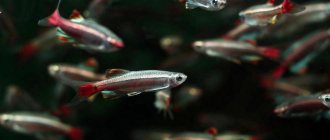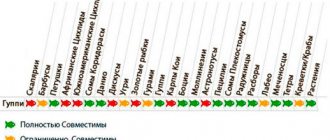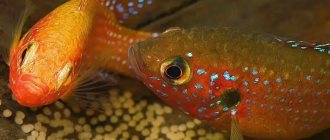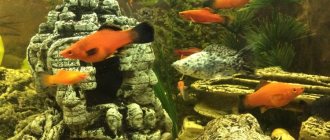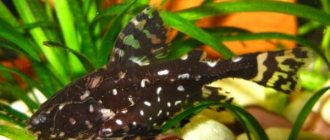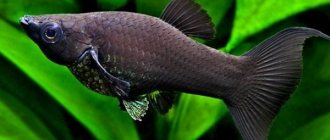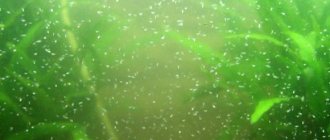Keeping aquarium fish at home
The word aquarium refers to any closed body of water artificially created by man to contain various aquatic inhabitants. At home, aquariums can be either freshwater or marine.
They are populated by various types of fish: both predatory and completely harmless, nimble and leisurely. Some of them feel comfortable in a flock of brothers, others stay in pairs, and there are also quite aggressive species.
Note: Whatever inhabitants you choose for your home aquarium, you should know that in a small aquarium the fish will not have enough space, so take care of a fairly spacious aquarium of any shape that suits you.
When installing your home pond, choose a place where it will not receive direct sunlight, so a window sill or a place near a window is not the best option for a location. However, placement in a fairly dark place requires additional lighting.
In addition to the container itself, you will need to purchase the following equipment (Figure 1):
- Compressor – serves to enrich water with oxygen;
- Filter – used to purify water from food residues and possible dirt;
- Heater – needed when keeping heat-loving fish;
- Lighting;
- A net for catching fish of the appropriate size;
- Scraper for cleaning walls from plaque;
- A tube with a siphon - used when replacing water, and also serves to remove waste or particles of uneaten food;
- Feeder for live or dry food.
Figure 1. Equipment needed to set up an aquarium
Temperature
The majority of aquarium fish feel comfortable at a water temperature of 22-26 degrees. Some species, such as discus and some labyrinths, need warm water (28-31 degrees), while others, such as goldfish, prefer cooler water (18-23 degrees). Based on this, the temperature regime is determined by the species that populate the aquarium (Figure 2).
Note: However, whatever the water temperature, it is important to avoid significant (2-4 degrees) temperature fluctuations, as this leads to illness in the fish. Such jumps most often occur in small aquariums (less than 50 liters) due to the rapid heating and cooling of small volumes of water. Leaving the window open for a long time in the cold season leads to hypothermia of the air, and, accordingly, the water in the aquarium. If the container is not equipped with a thermometer, then such fluctuations may even go unnoticed and lead to bacterial infection of the fish.
Particular attention should be paid not only to the temperature of the water, but also the air above it when keeping such species of fish as labyrinth fish, Siamese fighting fish, and lalius. This is explained by the fact that they capture air from the surface of the water, and if the air temperature is at least 5 degrees lower than the water temperature, then such fish can get sick and die. Therefore, when keeping certain species, special care must be taken when ventilating the room in which the aquarium is located.
Figure 2. Optimal temperature in the aquarium
On the other hand, overheating can also be dangerous. This is especially true for overfed fish, since they need more oxygen, and there is little of it in warm water. Under what conditions does water overheating occur? It can be a consequence of heating the aquarium by direct sunlight or the heat of heating devices and radiators located at a distance of less than half a meter from the aquarium. Lamps illuminating a pond with a tightly closed lid can also lead to overheating of the aquatic environment. Therefore, experienced aquarists advise making additional holes in the aquarium lid for ventilation.
Hardness of water
One of the most important conditions for the successful maintenance of aquatic life is water hardness. Total hardness consists of sulfate and carbonate. For the aquarium owner, carbonate hardness (kH) is more significant, since the solubility of carbon dioxide and the level of acidity depend on it. Hardness is determined as a percentage of calcium carbonate using special reagents. The higher the value, the worse the carbon dioxide will dissolve.
Note: The most acceptable water hardness values are: from 2 to 6 degrees carbonate hardness and 3-8 degrees total.
The percentage of water hardness increases when salts contained in stones and soil with which the water reacts are dissolved. Therefore, it is important to know that rocks and minerals located on the bottom of the aquarium can change the chemical composition of the water. Thus, limestone greatly increases the hardness of water, and corals and shells consist of calcium carbonate, that is, they are not suitable for decorating a reservoir with soft water.
Choosing a tank
Before thinking about creating an underwater kingdom, it is necessary to organize convenience and comfort for its inhabitants. Living conditions in the tank should be as close as possible to the natural environment. Therefore, you should first study our material, which describes detailed recommendations on how to choose an aquarium and equipment for it.
The most important thing: do not forget that an artificial “reservoir” is, first of all, a home for living organisms, and only then an element of decor.
Aquarium guppy fish: maintenance and care
The most common and popular aquarium fish is the guppy. The small size of these fish allows them to be kept even in a small aquarium of 15-30 liters. Guppies are not particularly picky about water quality, so if the aquarium is not too densely populated and planted with live plants, it is quite possible to abandon measures such as filtration and aeration of water (Figure 6). In this case, it is necessary to regularly change water and clean the soil. An ordinary table lamp will do as a source of additional lighting.
Guppies are unpretentious eaters: they can be fed with both dry and wet food. The fish happily pluck algae deposits from plants and stones. In addition, this type of fish can easily endure a week-long hunger strike, but overfeeding can spoil the water and kill the inhabitants of the aquarium. The lifespan of guppies is short, only a few years, and it depends on the water temperature. The higher it is, the shorter the guppy will live.
Figure 6. Methods for keeping guppy fish
Still, if you want to admire the large rainbow tails of male guppies, you will have to bring their conditions as close to ideal as possible. So, the optimal water temperature will be 24 degrees, and a third of it will have to be changed once a week for standing water at the same temperature. It is also useful to add table salt at the rate of 1 teaspoon per bucket of water. Lighting also plays an important role. In addition to additional, natural sunlight is also required.
Note: Elite guppy fish require much more maintenance, care and space than ordinary ones. For example, to maintain an elite male, one liter of water per individual is required, and for a female - 2 liters, provided that the water is filtered, as well as intensive aeration. Therefore, to keep several individuals you will need an aquarium with a capacity of 50 liters or more.
Male guppies sometimes fight for the female, but do not seriously injure each other. Most likely, they can suffer from other species of fish, larger in size, if kept together. Therefore, the best neighbors in the aquarium will be fish of peace-loving small species.
Check your oxygen levels
Not a single aquarium fish can survive in conditions of oxygen deficiency. Therefore, you definitely need to buy an aerator, but its power should not be too high. A specialized store will advise you on a suitable model.
If there is algae in the tank, the aerator should be left on overnight. Many plants release carbon dioxide abundantly at night, so if there is not enough oxygen, your aquarium inhabitants will die.
Aquarium betta fish: care and maintenance
The cockerel is an aquarium fish with fighting qualities and special beauty. Keeping this species together with other fish is almost impossible due to the cocky nature of the bettas.
The physiological characteristics of this species make it unpretentious and undemanding to water quality (Figure 7). This is due to the fact that in addition to gills, cockerels also have a special respiratory organ called the labyrinth. Here the blood is saturated with air, which the fish swallows through the mouth. Consequently, with such breathing it depends less on the oxygen saturation of the water.
Figure 7. Keeping betta fish
For this reason, caring for and maintaining aquarium fish (bettas) is not particularly difficult, since this does not require water filtration and aeration procedures.
Note: However, the optimal temperature should be maintained within the range of +24 - 28 degrees and the hardness from 4 to 15, as well as the corresponding acidity level - 6.0-7.5. The lifespan of fish and their size depend on these indicators.
When choosing an aquarium for keeping bettas, you should take into account that keeping one adult requires 3-4 liters of water. This species is an omnivorous fish: they eat both dry and live or frozen food. And yet, it will be better if you take care of live food (bloodworms, tubifex, zooplankton, even earthworms) for your pets. At one time, you need to pour in enough food so that it is completely eaten within 15 minutes. If food remains are visible after feeding, they must be removed immediately. Feeding is carried out 1-2 times a day. Overfeeding can cause obesity in cockerels, so it is recommended to arrange fasting days for them once a week.
You will find the necessary information about keeping betta fish in the video.
Selection rules
When getting unpretentious fish, you need to take into account the fact that there are principles for populating an aquarium that allow you to avoid most problems. When choosing fish, it is recommended to take these rules into account:
- compatibility of species - before purchasing, they clarify whether the fish can settle and whether they will oppress each other;
- similarity of species - it is optimal to populate the aquarium with representatives of similar species. It will be easier for them to create ideal conditions due to the similarity of requirements;
- size – the allowable number of inhabitants must be calculated based on their maximum size, and not what is available at the time of purchase;
- schooling - small fish are schooling, and you cannot buy them in pairs or individually.
By choosing the right pets, you get a luxurious pond with a minimum of hassle, but you must remember that both difficult-to-keep fish and aquarium fish are unpretentious - they all require attention and self-love.
Compatibility
Introduce aquarium inhabitants similar in character. Predators and aggressive large fish should not be placed with small peaceful species. Even calm, large inhabitants can inadvertently eat small ones. Mobile schooling fish will be bad neighbors for calm and slow species.
Number of fish for settlement
Universal rules for determining quantity:
- The aquarium population is selected based on the net volume of water. 10–15% of the space spent on decorations, plants and soil are not taken into account.
- Large fish are placed in a spacious aquarium. For small, active and social animals you will need a container of 40 liters or more.
- The calculation is based on oxygen exchange. If there are plants and additional sources of oxygen, then the number of inhabitants of the aquarium increases. To dissolve oxygen, the water temperature rises. Overpopulation is indicated by the concentration of fish near the surface even with good aeration.
- The larger the fish, the more waste it produces. To determine the permissible number of inhabitants, measure the level of nitrogen compounds and impurities in the water. Water tests are purchased at pet stores.
- In a mixed-sex aquarium, the number of females is 2-3 times greater than males.
These recommendations do not take into account the characteristics of individual representatives. Each aquarist must select the number of fish himself, monitoring the behavior of his fish and creating the maximum level of comfort for them.
Examples
- A 10 liter aquarium contains 4 guppies, cardinals or neons.
- For a flock of 4 danios, a pair of gourami or lalius, a 20-liter container is enough.
- A flock of cherry or four-striped barbs can be placed in a 40-liter pond.
- For one cockerel - 2 liters of water.
- A pair of angelfish, black-striped cichlas or large gourami will need an aquarium of 100 liters or more.
- Two small gouramis are placed in a 20-liter vessel.
- When settling catfish, other neighbors are often not taken into account, since the habitat occurs at different levels: catfish are at the bottom, and the rest inhabit the middle and upper tier.
Aquarium fish Labeo: contents
A popular aquarium fish of the carp family is the labeo. This is a species of fairly large fish (up to 15 cm in length), living for about 5-6 years. Labeos feed on food containing plant fiber. Additionally, they can be fed vegetables: pieces of zucchini, cucumbers, lettuce. They also eat animal food with pleasure, but they are not at all attracted to algae (Figure 8).
To keep a labeo you will need a spacious aquarium with a volume of at least 200 liters, since this type of fish is territorial and becomes aggressive when overcrowded. In addition, the aquarium labeo jumps well, so you should make sure that the aquarium is covered with a lid.
Figure 8. Methods for keeping labeo fish in an aquarium
In general, caring for labeo is simple and consists of providing space and a large number of plants on which the fish finds food for itself without damaging the plants themselves. This species loves clean, fresh water, so filtration and water changes must be mandatory. The optimal water hardness and temperature range from +22 to +26 degrees.
Carp
Popular inhabitants of freshwater aquariums. Decorative natives of the carp family are selectively bred and are known for their varied appearance and adaptation to the conditions of an artificial reservoir.
Barbus
The size of barbs does not exceed 10 cm. Energetic schooling fish are dangerous for small neighbors with long fins. They live in a spacious aquarium with similar temperamental neighbors. The most unpretentious aquarium fish are the Sumatran barb and the cherry barb.
Danio
Danios have a completely ordinary appearance, but they captivate with their activity and swiftness. The fish is schooling, but does not require much space; 8-10 individuals can live perfectly in a twenty-liter aquarium.
Cardinal
Small and, at first glance, not the most elegant pets, they are distinguished by bright fins. These are the most unpretentious fish for an unheated aquarium. Like the previous species, they are kept in a flock of 6 or more. The nature of the fish is peaceful and they live without problems together with other small peace-loving fish. Cardinals are just multiplying. They enliven the home pond and are appreciated not only by beginners, but also by professionals.
Aquarium fish angelfish: care and maintenance
A popular species for aquarium keeping are angelfish, which, due to their unusual body shape, are rightfully considered an adornment of the underwater kingdom (Figure 9).
The fish is quite unpretentious to the conditions of detention. Thus, the temperature regime of the aquatic environment can vary from +22 to +26 degrees. At the same time, this type of fish can easily tolerate a significant drop in temperature down to +18. Since the angelfish is a fairly large fish, to keep it you will need an aquarium with a capacity of at least 100 liters and a height of more than 50 cm. Moreover, it must be densely populated with plants.
Figure 9. Rules for keeping angelfish
Regarding nutrition, angelfish prefer to eat live food, although they do not refuse dry food. It would be useful to know that due to its large size, this type of fish cannot pick up particles of food that have sunk to the bottom. Therefore, nutrition must be organized so that the fish can absorb food while it slowly sinks from the surface to the bottom of the aquarium. Angelfish are fed twice a day. In addition, it is recommended to arrange a fasting day for them once a week, since overeating is extremely undesirable for these aquarium inhabitants.
Pisces compatibility
When the aquarium is ready to move in, the owners want to add as many fish as possible. But this cannot be done. First, you need to ask the store or read information about what species this or that fish gets along with.
- Compatibility of keeping aquarium fish is an important factor that must be adhered to.
- After all, there are peaceful fish that get along with everyone, and there are predators that can attack peaceful pets and ultimately destroy them.
- Also an important factor is the requirement for keeping different types of fish.
- It is desirable that the fish can be together in a certain temperature regime, water hardness and acidity.
There are also viviparous and egg-laying fish, which also affects their compatibility in the same aquarium.
When these conditions are met in choosing pets, you will not lose them and will be able to enjoy their peaceful coexistence.
Aquarium Triton: keeping with fish
If you want to diversify the aquatic world of the aquarium with a newt, you should know that the upper limit of the acceptable temperature of the aquatic environment for it is +22 degrees, while for most fish the optimal temperature is above +25. Therefore, the water in the aquarium will have to be periodically cooled using bottles of ice (Figure 10). In addition, not every species of fish is suitable for keeping with this amphibian. Guppies, neons, cardinals, and goldfish get along better than others with newts.
Note: The aquarium containing the newt must be equipped with a good filter, and a fifth of all water must be changed every week. It is important to know that one amphibian will need 10 to 15 liters of water.
As for bottom soil, a rounded substrate of a fairly large size is best so that the newt cannot swallow it. It is advisable to plant the soil with aquarium plants, since amphibians need them for wrapping eggs. Use fluorescent lamps for lighting as they do not heat the water.
Figure 10. Newt content in the aquarium
Newts prefer live food: bloodworms, tubifex, earthworms and snails are their favorite delicacy. Amphibians will not refuse finely chopped liver, shrimp and squid. A peculiarity of feeding newts is the fact that these animals only see moving food, so you can put food on them using tweezers. Young individuals should be fed several times a day, and adults every other day.
Changing water
Caring for fish is closely related to caring for the aquarium itself. Many beginners begin to change the water prematurely, as soon as the water becomes slightly cloudy. The fact is that this is a closed ecosystem, so such haste leads to its destruction, therefore, you will have to “start” your aquarium again. Need I say that fish will not react in the best way to such stress?
A universal recommendation is to drain about a third of the water from the tank, adding fresh water to it, i.e. A complete water change cannot be carried out.
Aquarium goldfish: care and maintenance
Aquarium goldfish are one of the subspecies of silver crucian carp. To maintain them, you need a spacious aquarium of 2 dm2. bottom area per 1 long-bodied individual and 1.5 dm.sq. for 1 short-bodied. In this case, the shape of the aquarium itself plays an important role. The best option would be to choose a classic shape, in which the length is twice the width, and the height of the water layer is no more than 50 cm (Figure 11).
Figure 11. Keeping goldfish in an aquarium
It is recommended to use large gravel or pebbles as soil. Since goldfish love to burrow in the soil and dig up plants, you will need a powerful filter to eliminate regular cloudiness in the water, and the plants themselves will have to be planted in pots. Make sure you have good natural light as well. If we talk about the temperature regime, then for long-bodied fish the optimal temperature will be from +17 to +26, and for short-bodied fish - from +21 to +29 degrees. In this case, the water hardness should be at least 8. Goldfish tolerate salt water well, so if they are feeling unwell, it is recommended to add 5-7 g of salt per liter to the aquatic environment. Remember to regularly replace part of the total water volume in the aquarium.
Note: These fish are friendly and are well suited to being kept with species other than veiltails. But due to their natural slowness and blindness, goldfish often go hungry, since their more nimble neighbors manage to collect all the food before them.
Their diet can include a variety of foods: live earthworms and bloodworms, white bread and mixed feed, unsalted oatmeal and semolina, minced meat, salad, seafood. However, it is not advisable to feed goldfish exclusively with live food, as they may experience digestive upset. Therefore, it is recommended to soak dry food with aquarium water in a separate container before feeding.
Like other fish species, goldfish should not be overfed to prevent obesity and infertility. Therefore, the feeding procedure is carried out twice a day for 15 minutes, then the remaining uneaten food is immediately removed.
Install a filtration system
A properly selected artificial filtration system will help keep water clean longer and prevent the growth of harmful bacteria.
Natural filters such as Siamese algae eaters, otocinclus, ancistrus, shrimp and neretina snails will help maintain a healthy ecosystem and extend the time between cleaning the aquarium. The latter are unpretentious and do an excellent job of cleaning the aquarium from soft waste, algae on the walls, plants and decor. The only disadvantage of snails is their high reproduction rate.
Aquarium crayfish: keeping with fish
Unlike newts, aquarium crayfish are quite easy to care for, however, they are not suitable for keeping in a community aquarium, since they have the habit of hunting large fish at night. This is especially true for slow-moving species or those that live near the bottom (Figure 12).
Note: There are cases when crayfish themselves become victims of certain types of cohabitants. For example, a cichlid easily tears apart an adult crayfish. Therefore, the best way out would be to keep the crayfish separate from other species of aquatic life.
Most of them feel great in cool water, and only a few prefer warm water. A small aquarium with a volume of 30-40 liters is quite suitable for keeping one individual crayfish. You should know that the water in an aquarium containing crayfish requires fairly frequent changes and regular cleaning. It is safest to use an internal filter to cut off the crayfish's escape routes from the aquarium. For the same reason, your aquarium should be well covered.
Figure 12. Keeping crayfish in an aquarium
If you want to keep several individuals, make sure that there is enough space in your home pond for all crayfish, as these animals are known for their tendency to cannibalism. That is why every molted crayfish should have the opportunity to find its own secluded place in the aquarium, where it can wait out the bad times.
Basic mistakes of newbies
The main rule for breeding a particular fish is to have enough space for all the little ones. Sometimes newbies make a huge mistake and overpopulate the water tank. For fertilization, fish require a large space and a lot of stones and decorations to hide from other individuals.
How to choose an aquarium: tips on how to choose the right size, material and shape. Necessary equipment for aquariums (100 photos)Types of aquarium fish: 150 photos of the most popular and unique inhabitants of aquariums
Keeping aquarium fish: rules, regulations, recommendations and tips for beginners (140 photos and videos)
In addition, creatures are capable of dying out if their genotype does not develop or the males are infertile. To do this, it is important to cross fish of different breeds, where there will be no likelihood of closely related relationships.
The last item should be fish food, which does not have to be Premium. Breeders without experience often spend money on expensive bags of food, while forgetting about other maintenance items. It is enough to select food for fish according to the principle of composition. The composition should contain vitamins, minerals, acids and other beneficial substances.
Description
The Barbus genus belongs to the Carp family. The homeland of barbs is South-West Asia (Sumatra, Borneo, Thailand, Cambodia). In addition, these fish are found in India, equatorial Africa, and on the island of Sri Lanka. Thanks to their endurance and good adaptability, some species of the genus have taken root in water bodies of the USA, Australia, Colombia, and Singapore. In nature, these fish inhabit slow-moving rivers and streams with a sandy bottom and dense vegetation.
The sizes of barbs range from 5 to 35 cm, depending on the type. The description of the appearance of most species is similar - they are fish with an elongated body, pointed in the front, and a two-lobed caudal fin. Some species have antennae. Sexual dimorphism is weakly expressed: females usually have a more rounded abdomen and less bright color than males.
These are schooling fish; They are recommended to be kept in groups of 6-10 individuals. When kept alone, these fish experience stress and begin to show aggression towards other inhabitants of the aquarium. Barbs are very mobile and swim quickly, so there should be enough free space in the artificial pond.
